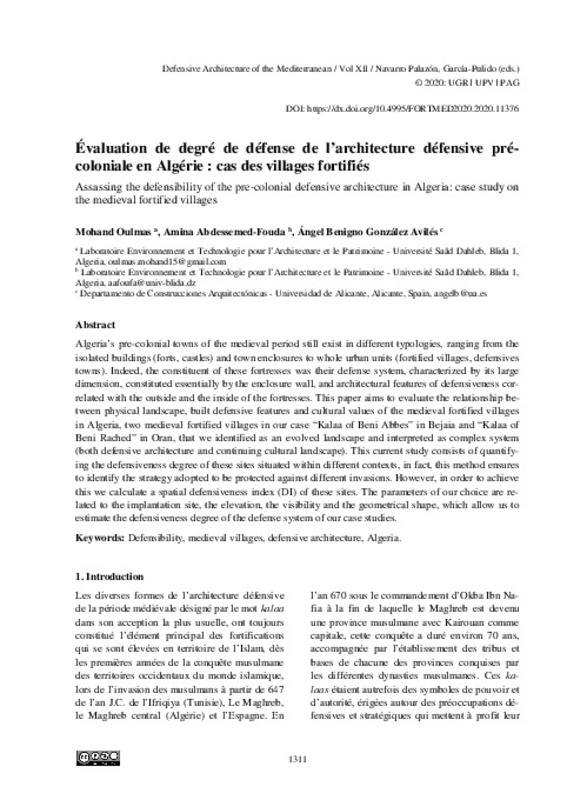JavaScript is disabled for your browser. Some features of this site may not work without it.
Buscar en RiuNet
Listar
Mi cuenta
Estadísticas
Ayuda RiuNet
Admin. UPV
Évaluation de degré de défense de l’architecture défensive pré-coloniale en Algérie : cas des villages fortifiés
Mostrar el registro sencillo del ítem
Ficheros en el ítem
| dc.contributor.author | Oulmas, Mohand
|
es_ES |
| dc.contributor.author | Abdessemed-Fouda, Amina
|
es_ES |
| dc.contributor.author | González Avilés, Ángel Benigno
|
es_ES |
| dc.coverage.spatial | east=5.055683699999999; north=36.7515258; name=Bejaia, Béjaïa, Algèria | es_ES |
| dc.coverage.spatial | east=-0.6349319; north=35.6987388; name=Rue Colonel Abdelkader Chabou, Oran, Algèria | es_ES |
| dc.date.accessioned | 2020-06-18T07:05:13Z | |
| dc.date.available | 2020-06-18T07:05:13Z | |
| dc.date.issued | 2020-05-15 | |
| dc.identifier.isbn | 9788490488560 | |
| dc.identifier.uri | http://hdl.handle.net/10251/146554 | |
| dc.description.abstract | [EN] Algeria’s pre-colonial towns of the medieval period still exist in different typologies, ranging from the isolated buildings (forts, castles) and town enclosures to whole urban units (fortified villages, defensives towns). Indeed, the constituent of these fortresses was their defense system, characterized by its large dimension, constituted essentially by the enclosure wall, and architectural features of defensiveness correlated with the outside and the inside of the fortresses. This paper aims to evaluate the relationship between physical landscape, built defensive features and cultural values of the medieval fortified villages in Algeria, two medieval fortified villages in our case “Kalaa of Beni Abbes” in Bejaia and “Kalaa of Beni Rached” in Oran, that we identified as an evolved landscape and interpreted as complex system (both defensive architecture and continuing cultural landscape). This current study consists of quantifying the defensiveness degree of these sites situated within different contexts, in fact, this method ensures to identify the strategy adopted to be protected against different invasions. However, in order to achievethis we calculate a spatial defensiveness index (DI) of these sites. The parameters of our choice are related to the implantation site, the elevation, the visibility and the geometrical shape, which allow us toestimate the defensiveness degree of the defense system of our case studies. | es_ES |
| dc.language | Francés | es_ES |
| dc.publisher | Editorial Universitat Politècnica de València | es_ES |
| dc.rights | Reconocimiento - No comercial - Sin obra derivada (by-nc-nd) | es_ES |
| dc.subject | Fortifications | es_ES |
| dc.subject | Mediterranean | es_ES |
| dc.subject | Modern age | es_ES |
| dc.subject | Built Heritage | es_ES |
| dc.subject | Defensibility | es_ES |
| dc.subject | Medieval villages | es_ES |
| dc.subject | Defensive architecture | es_ES |
| dc.subject | Algeria | es_ES |
| dc.title | Évaluation de degré de défense de l’architecture défensive pré-coloniale en Algérie : cas des villages fortifiés | es_ES |
| dc.title.alternative | Assassing the defensibility of the pre-colonial defensive architecture in Algeria: case study on the medieval fortified villages | es_ES |
| dc.type | Capítulo de libro | es_ES |
| dc.type | Comunicación en congreso | es_ES |
| dc.identifier.doi | 10.4995/FORTMED2020.2020.11376 | |
| dc.rights.accessRights | Abierto | es_ES |
| dc.description.bibliographicCitation | Oulmas, M.; Abdessemed-Fouda, A.; González Avilés, ÁB. (2020). Évaluation de degré de défense de l’architecture défensive pré-coloniale en Algérie : cas des villages fortifiés. Editorial Universitat Politècnica de València. 1311-1318. https://doi.org/10.4995/FORTMED2020.2020.11376 | es_ES |
| dc.description.accrualMethod | OCS | es_ES |
| dc.relation.conferencename | FORTMED2020 - Defensive Architecture of the Mediterranean | es_ES |
| dc.relation.conferencedate | Octubre 01-03,2020 | es_ES |
| dc.relation.conferenceplace | Granada, Spain | es_ES |
| dc.relation.publisherversion | http://ocs.editorial.upv.es/index.php/FORTMED/FORTMED2020/paper/view/11376 | es_ES |
| dc.description.upvformatpinicio | 1311 | es_ES |
| dc.description.upvformatpfin | 1318 | es_ES |
| dc.type.version | info:eu-repo/semantics/publishedVersion | es_ES |
| dc.relation.pasarela | OCS\11376 | es_ES |








